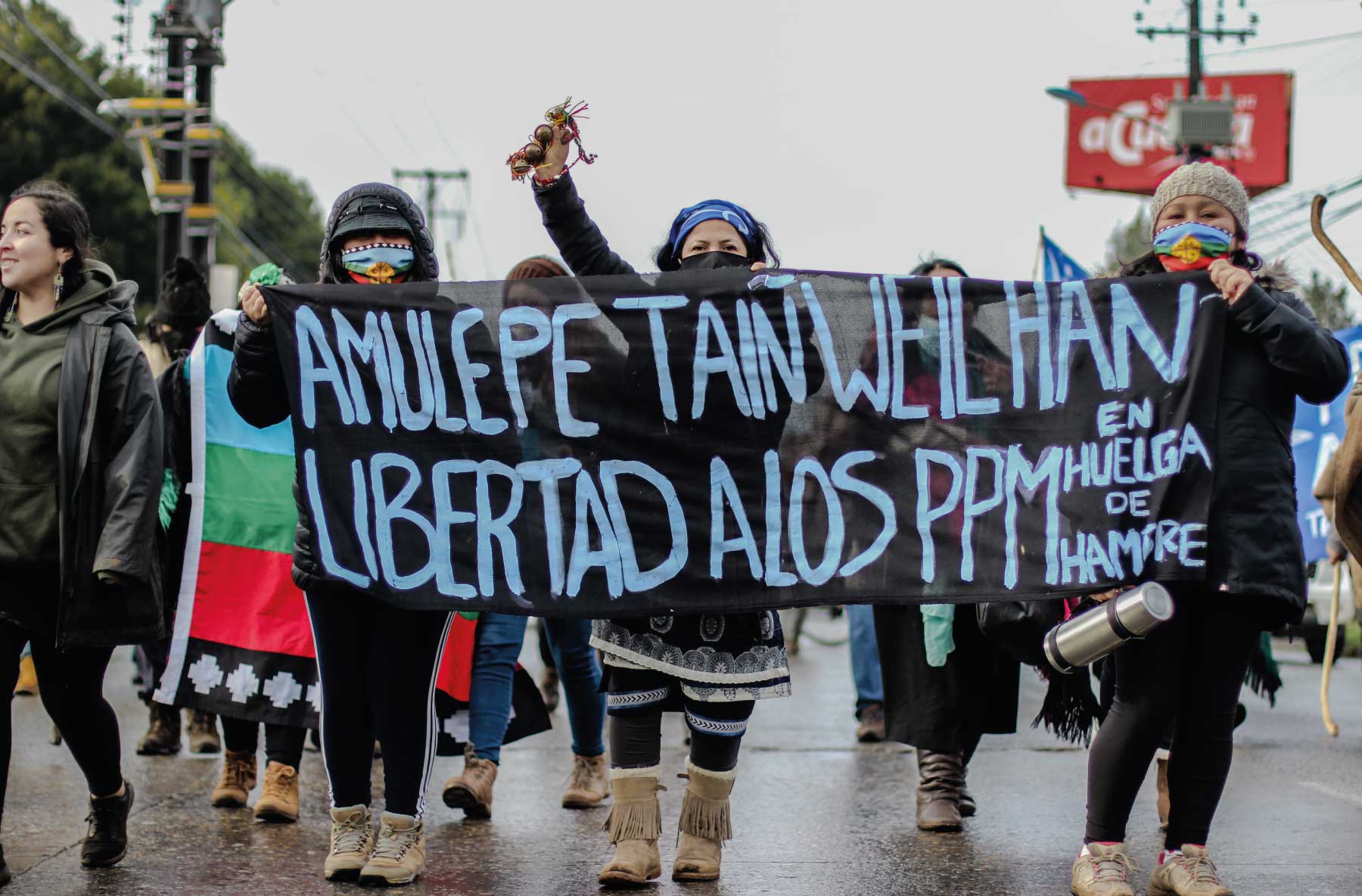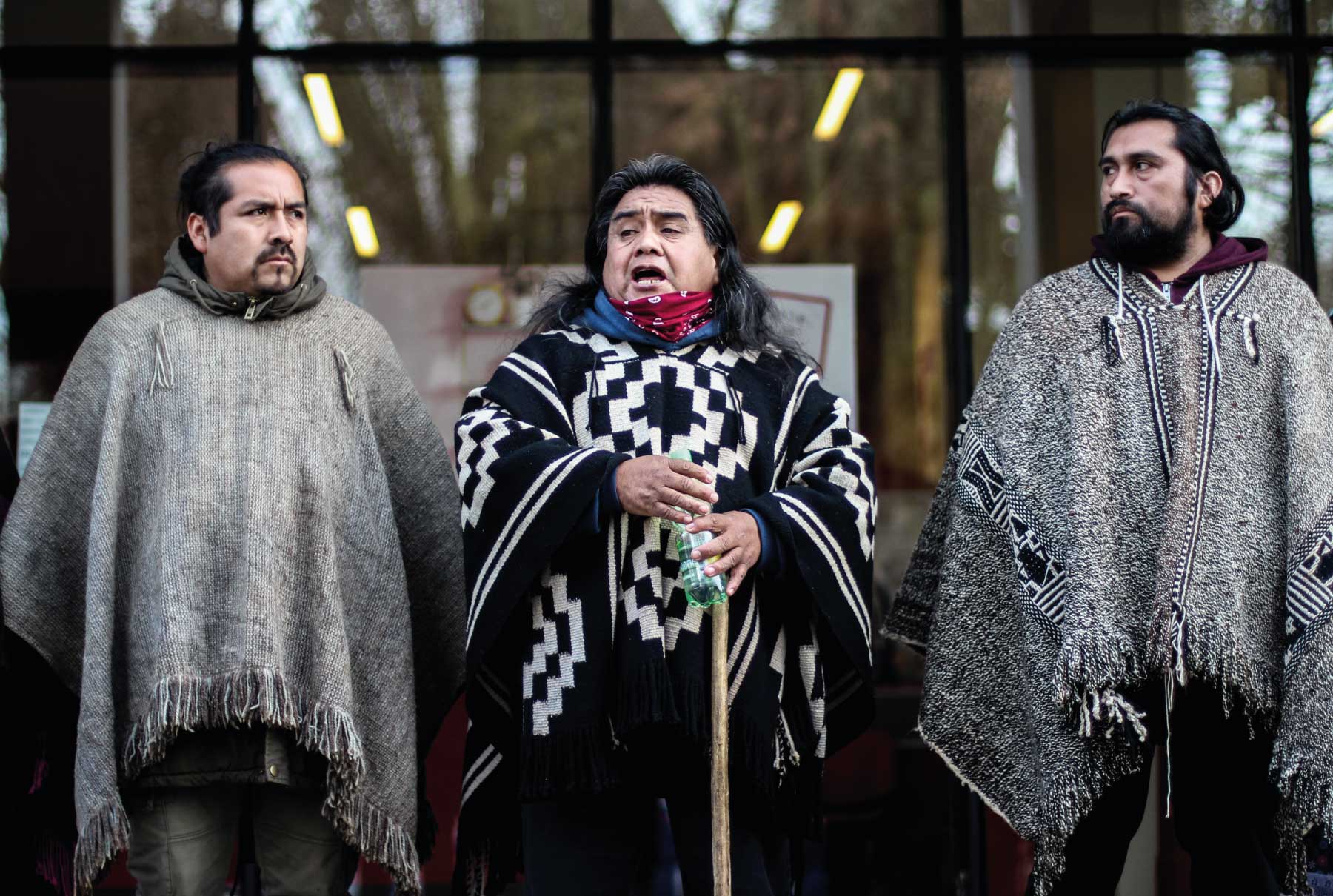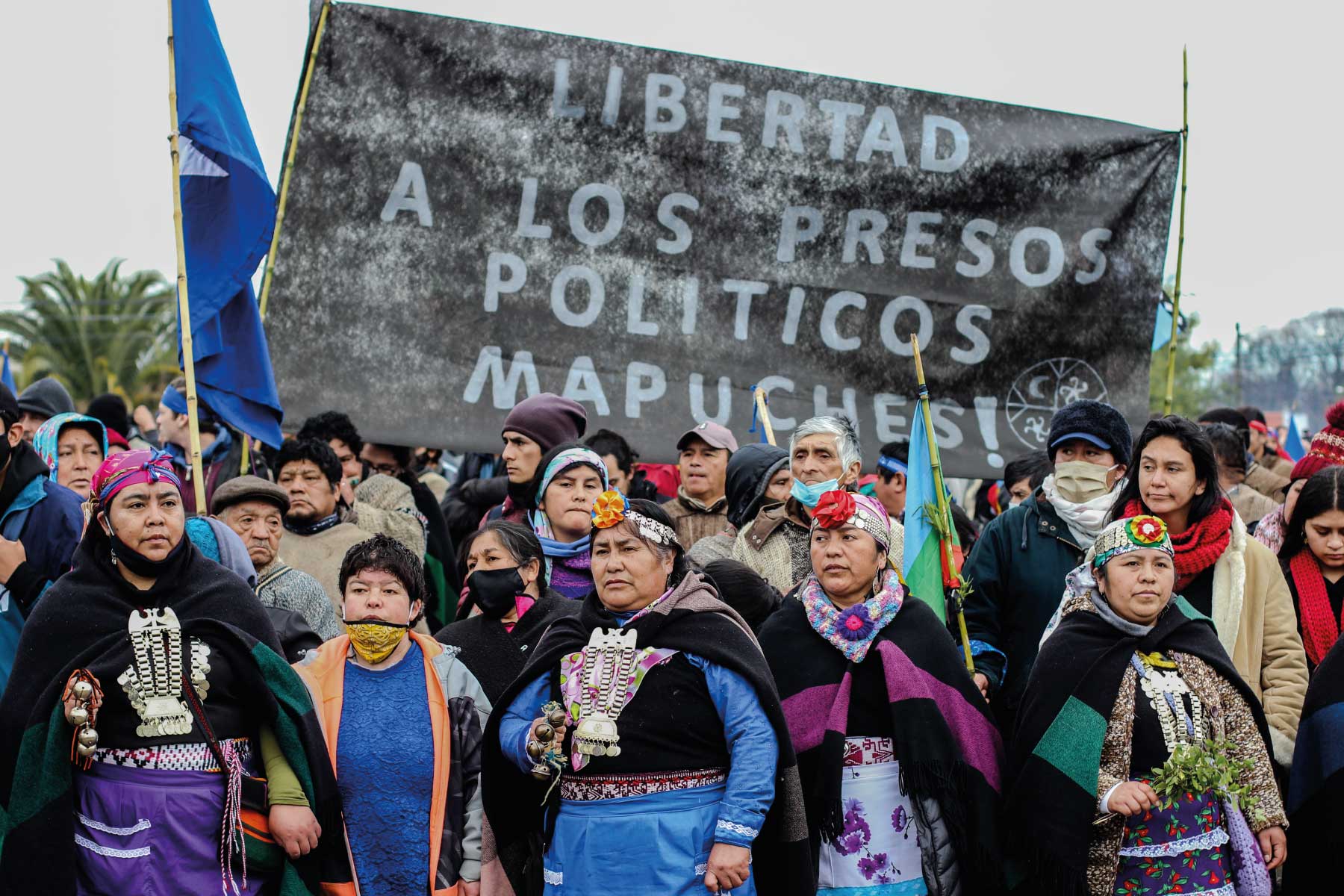Mapuche political prisoners use their own bodies and resort to a solid and liquid food hunger strike as resistance tools against the Chilean state, police repression and the harassment by landowners and multinational corporations.
Mapuche political prisoners use their own bodies and resort to a solid and liquid food hunger strike as resistance tools against the Chilean state, police repression and the harassment by landowners and multinational corporations. Treated as “terrorists” and branded as the “internal enemy” by the holders of economic power, the strikers give away their newen (strength) while trying to obtain freedom for their people.
I dreamt I was dreaming:
that we were subdued
and governed by tyrants.
I choose a hunger strike
to awaken the rage,
to take the leap
and annihilate the dream.
Juan Jerónimo Lemus, Cherán, México.
While I am writing this article, Mapuche political prisoners on a hunger strike are going through crucial moments. Farmers in Lebu prison have not eaten for 50 days and those in Angol for 113 days. In addition to that, on August 24, they started dry fasting, which could be the most extreme prison measure a human being can take when locked in jail. Even though the prisoners in Temuco have not yet joined this initiative, they have been on a hunger strike for 42 days. These actions and various other protests around the world made it possible for machi Celestino Córdova to twist the hand of the powerful and to reach basic agreements as long as the hunger strike came to an end.
Nevertheless, in the meantime, the Chilean government has done the bare minimum to unlock the conflict with the strikers. This is understandable since, basically, their demands aim at regulating imprisonment related to indigenous causes according to international legislation guidelines, included in ILO Convention 169 adopted by Chile over a decade ago.
“The strikers aim at regulating imprisonment related to indigenous causes according to international legislation guidelines, included in ILO Convention 169”.
In order to understand the situation, it is necessary to explain the reasons that motivated the political imprisonment of many farmers. In the early morning of January 29, over a hundred police officers violently searched five households in Valle de Elicura, Lavkenche land in Wallmapu. Following the struggle, punches and attacks on their families, Matías Leviqueo, Eliseo Raiman, Guillermo Camus, Esteban Huichacura, Carlos Huichacura and Manuel Huichacura were arrested. In the afternoon, the accused were held in preventive custody and charged with the alleged participation in the murder of a neighbor of the area.
In the arraignment, it was determined that the only evidence against them were statements given by protected witnesses. Not only were those statement contradictory, but also the alleged witnesses failed to establish a connection between the accused and the crime. Ignoring these legal loopholes, the peñi from Valle de Elicura were taken to Lebu prison in the province of Arauco, where they are currently on a hunger strike.

Protest in Angol in support of Mapuche political prisoners on a hunger strike during July 2019. Photo: Julio Parra.
Weichan, the creation of the internal enemy and the counterinsurgency
During the 90s, the emergence of the Mapuche movement, in general, and its autonomous trait, in particular, sparked, for the first time, a crisis in the monocultural structure reproduced by the Chilean Nation-State throughout its modern history. The lengthy creole chileanization imposed by blood, fire, and the law and crystalized by Augusto Pinochet’s saying “there are no more Mapuches left, because we are all Chilean” were profoundly questioned by a people willing to transform their reality.
Land recovery was taking place, political organizations were growing in number and weichan (the historical tradition of Mapuche antagonism) became the rule for those sectors that did not trust neoliberal institutions. The first collective insubordination mobilizations occurred in the Lavkenche area: the Coordinadora Arauco Malleco (CAM) was born and, with it, a legacy of rebellion that kept growing until this day. The process of reclaiming lands in Valle de Elikura, for example, is the consequence of a whole Lavkenche generation willing to self- determine its present and future.
In this context, and with their interests being threatened during the successful “Chilean miracle”, the ruling class rearranged its structures of power to face the emergence of a new “internal enemy”. The fighting Mapuche played the preferred part of a race-based terrorist. Criminalization seemed to be the most effective way to address this “innovative” threat. This is how a new cycle that might be described as a “Low Intensity Conflict” began. That is, a counterinsurgency scenario based on passive and coercive methods of subjugation, co- optation, exploitation and persecution of enemies of the model.
“Creole chileanization imposed by blood, fire, and the law and crystalized by Augusto Pinochet’s saying “there are no more Mapuches left, because we are all Chilean” were profoundly questioned by a people willing to transform their reality.”
It is a low intensity conflict that covers a counterinsurgent and neocolonial attack against the Mapuche people in weichan and that is developed in three interconnected levels. First, a comprehensive mechanism created by the ruling sectors to corner the resistance, thus, enabling accumulation due to deprivation and the wide reproduction of capital. At a regional level, it is possible to see this in the Initiative for the Integration of the Regional Infrastructure of South America (IIRSA) and the Trans-Pacific Partnership (TPP-11). At a national level, the Plan Araucanía, the attempts to reform the Indigenous Law and the Modernization and Extension of Arauco Mill (in Spanish, MAPA). These economic and political initiatives have three objectives: the definite opening of Wallmapu to transnational corporations, looting and spoliation of natural resources, and the submission of the land protest. In sum: the real subjugation of nature, spiritual believes and political capabilities of the Mapuche resistance to capital.
However, even if the coercive logic of these plans comes has a transnational origin driven by the interests of contemporary imperialism, its operative capacity resides in the development of a variety of national causes brought to affirm the Chilean doctrine of “national security” against this new “internal enemy”. In this second level, we will find the persecution and criminalization plans promoted by the State during the last two decades to debilitate autonomous Mapuche movement and to accuse it of “terrorism”. “Operación Paciencia” (2002-2004) aimed at breaking the CAM apart, the ridiculous “Operación Huracán” articulated by the media to “behead” Weichan Auka Mapuche and, once more, the CAM, and Operación Andes (2017), which intended to connect weichan Mapuche organization with arms trafficking and with political and military structures from different territories.

Protest in Angol in support of Mapuche political prisoners on a hunger strike during July 2019. Photo: Julio Parra.
The use of the terrorism card as a landowners’ strategy
The “fight against terrorism” is also the stubborn objective of landowners, forest businessmen and agriculture trades belonging to the regional far-right wing who inhabit the Wallmapu today. The heirs of settler colonialism benefited from land dispossession, displacement and racial subordination of the Mapuche. They insist and justify their historical presence, their properties and investments by defending an alleged nationalist white supremacy associated with the rule of the law. In order to do so, apart from creating the idea of a “terrorist Mapuche”, they have organized paramilitary self-defense groups that threaten to increase the violence initiated by themselves and their ancestors.
Particularly, for Lavkenmapu and Valle de Elikura, counterinsurgency is evidenced in the systematization of data brought to light by the press agency Mapuche Aukin titled “The new repressive plan for the Lavkenche area” (in Spanish, “El nuevo plan represivo para la franja lavkenche”). This document summarizes those measures the government – as discussed with the “main” production sectors of the area – would take in the south of the province of Arauco in order to mitigate the “rural violence” rate, a media category used to refer to the Lavkenche resistance. The creation of new police sub-precincts, the arrival of 100 officers to the area, the permanent presence of police posts, the arrival of 16 all-terrain armored vehicles, a helicopter and the donation of state-of-the-art drones could be just part of the repressive plan created to persecute the Lovs and those communities that defend Lavkenche territory.
“These cases are not necessarily intended to obtain a conviction. To the contrary, they aim at neutralizing Mapuche fighters, at tiring the resistance movement and at forcing them to challenge the government’s agenda.”
The most specific level of conflict is related to Mapuche political prison. It is not a secret that prisons in Latin America have color, as described by anthropologist Rita Segato. It is not just that, however. Judicialization of the indigenous protest also has color. During the last three decades, in Chile, activists, leaders and cultural authorities of the Mapuche people have been systematically subjected to long judicial proceedings which generally conclude with acquittals or dismissals of the case due to lack of evidence.
Nonetheless, these cases, famous for their technical inconsistencies and legal loopholes, are not necessarily intended to obtain a conviction. To the contrary, they aim at neutralizing Mapuche fighters, at tiring the resistance movement and at forcing them to challenge the government’s agenda. Having said the above, there are breaking moments when the Mapuche movement sets the pace of the agenda and forces the government to negotiate, as seen in the last few weeks.
This way, we can appreciate that political prison generates cohesion among sectors that are organically dissimilar and, at the same time, puts pressure on the supporting movement to focus on immediate objectives (generally disregarding strategic purposes). In this context, the release of the prisoners or the improvement of the prison conditions become an undeniable priority. The indirect beneficiaries are the ruling classes who “maintain” the Mapuche insubordination focused on one sole objective that requires the use of a wide range of alliances, negotiations and rebellious practices. Moreover, actions in support of political prisoners and, particularly, in support of the hunger strikes are emotional processes which are materially exhausting for a movement that does not have extensive solidarity networks outside Wallmapu or even an abundance of resources.

Protest in Angol in support of Mapuche political prisoners on a hunger strike during July 2019. Photo: Julio Parra.
Cruelty as a counterinsurgent biopolitical device
Prison and hunger strikes are disciplinary mechanisms for the individual and his body, which extend as a pain mechanism to the families and close relationships who accompany this process. Liquid and dry fasting, which cause chronic damage to the body of the individual doing them, is combined with the suffering caused by arrests, searches and the long judicial proceedings leading to imprisonment.
In the last three decades, hundreds of women, men, elderly people, boys and girls have suffered the violence of these counterinsurgent biopolitical mechanisms, which leave an indelible imprint on their lives. At their short age, several pichikeche (boys and girls) have spent their childhoods in militarized territories, facing police harassment and the gloomy corridors of the Courts of Justice. In this sense, and without devaluing the humanitarian aid provided, it is important to mention that women are the ones who generally carry out a great deal of the support tasks since, apart from working full-time in the camps rudimentarily set up outside the prisons, they have to take care of the daily household and Lov chores.
“The coercive action of Chilean and transnational elites cannot bend the collective will of the strikers.”
Despite all this, the coercive action of the power structure formed by Chilean and transnational elites cannot bend the collective will of the strikers. Mapuche political prisoners are not fighting for an individual demand: the hunger strike with which they are risking their lives aims at setting a basic legal framework for indigenous political prison in Chile to become visible.
From their cells, Mapuche political prisoners face every repressive action of the counterinsurgency. They combat the violence of economic lobbies, political structures, judicial power and repressive mechanisms with afafanes (roars of encouragement), ceremonies and small tokens of solidarity. It is an uneven fight, without a doubt, but as heartbreaking as this process may be, Mapuche political prisoners represent the greatest expression of human dignity possible: they give away their vitality and their newen (strength) in order to obtain freedom for their people.
* Text in honor of the noble resistance of Mapuche political prisoners on a hunger strike in Lebu prison: Matías Leviqueo, Eliseo Raiman, Tomás Antihuen, Guillermo Camus, Esteban Huichacura, Carlos Huichacura, Manuel Huichacura, Cesar Millanao, Orlando Saez, Damian Saez, Robison Parra, Oscar Pilquiman. It is also written with much affection in honor of Kelüray and Külapangui, seeds of rebellion in the Lavkenmapu.
